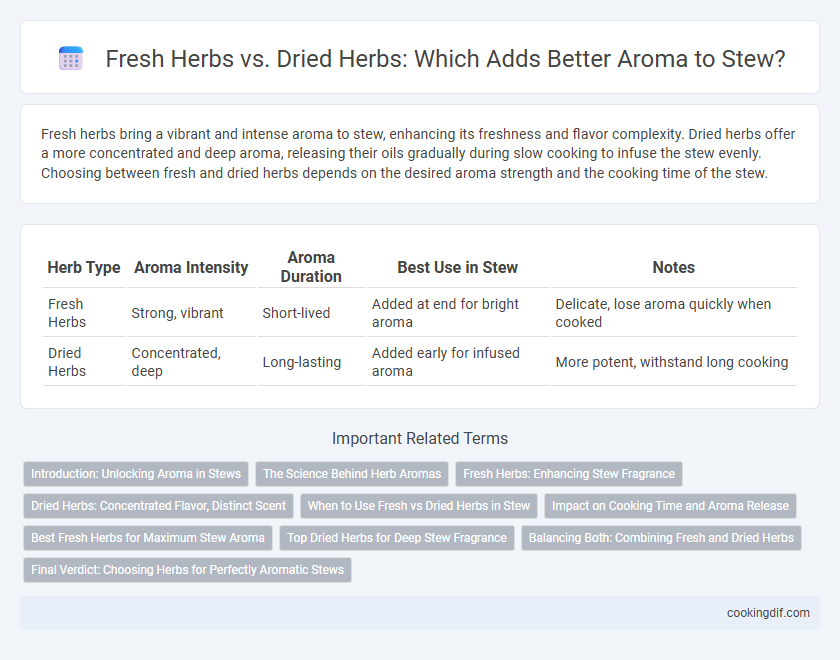Fresh herbs bring a vibrant and intense aroma to stew, enhancing its freshness and flavor complexity. Dried herbs offer a more concentrated and deep aroma, releasing their oils gradually during slow cooking to infuse the stew evenly. Choosing between fresh and dried herbs depends on the desired aroma strength and the cooking time of the stew.
Table of Comparison
| Herb Type | Aroma Intensity | Aroma Duration | Best Use in Stew | Notes |
|---|---|---|---|---|
| Fresh Herbs | Strong, vibrant | Short-lived | Added at end for bright aroma | Delicate, lose aroma quickly when cooked |
| Dried Herbs | Concentrated, deep | Long-lasting | Added early for infused aroma | More potent, withstand long cooking |
Introduction: Unlocking Aroma in Stews
Fresh herbs release vibrant, complex aromas in stews due to their higher essential oil content, enhancing the overall flavor profile with bright and lively notes. Dried herbs possess a more concentrated flavor intensity but may impart a deeper, earthier aroma after prolonged cooking. Balancing fresh and dried herbs unlocks a rich, layered aromatic experience in stews, maximizing both fragrance and taste.
The Science Behind Herb Aromas
Fresh herbs contain higher concentrations of volatile oils responsible for strong, vibrant aromas, while dried herbs lose some essential oils during drying but develop intensified flavors due to chemical transformations. The science behind herb aromas reveals that compounds like terpenes and phenolics degrade differently, impacting the scent profile depending on whether the herb is fresh or dried. Understanding these biochemical changes helps cooks select the ideal herb form to achieve the desired aromatic intensity in stews.
Fresh Herbs: Enhancing Stew Fragrance
Fresh herbs such as thyme, rosemary, and parsley release essential oils that intensify the aroma of stew, providing a bright and vibrant fragrance. Their volatile compounds infuse the dish with a fresh, green scent that dried herbs often lack due to the dehydration process. Using fresh herbs towards the end of cooking preserves their aromatic qualities, significantly enhancing the overall sensory experience of the stew.
Dried Herbs: Concentrated Flavor, Distinct Scent
Dried herbs offer a concentrated flavor that intensifies the aroma of stews, releasing distinct, robust scents as they simmer. Unlike fresh herbs, their potency increases with heat and time, making them ideal for slow-cooked dishes where layers of rich herbal notes develop. The drying process preserves essential oils, ensuring a deep, lasting fragrance that enhances the overall sensory experience.
When to Use Fresh vs Dried Herbs in Stew
Fresh herbs deliver a vibrant aroma and are ideal for finishing stews to preserve their bright, delicate flavors. Dried herbs release their essential oils slowly, making them perfect for simmering in the early stages to infuse deep, robust aromas throughout the stew. Using fresh herbs like parsley or basil at the end enhances freshness, while dried thyme, rosemary, or bay leaves added during cooking enrich the stew's overall complexity.
Impact on Cooking Time and Aroma Release
Fresh herbs release their aromatic oils more rapidly during cooking, enhancing the stew's aroma earlier, while dried herbs require longer cooking times to fully infuse their flavors. Incorporating fresh herbs near the end of the cooking process preserves their vibrant aroma, whereas dried herbs benefit from extended simmering to soften and unlock their essential oils. The choice between fresh and dried herbs directly impacts the stew's aroma profile and optimal cooking duration for flavor development.
Best Fresh Herbs for Maximum Stew Aroma
Fresh herbs like rosemary, thyme, and parsley release vibrant essential oils that amplify the aroma of stew, offering a more intense and natural scent than dried herbs. Using fresh bay leaves and oregano enhances the depth of flavor while preserving the bright, aromatic notes that dried herbs often lack due to the drying process. Selecting the best fresh herbs ensures maximum aroma retention, enriching the stew with a complex and inviting fragrance profile.
Top Dried Herbs for Deep Stew Fragrance
Dried herbs such as thyme, rosemary, and bay leaves are essential for achieving a rich, deep aroma in stews, as their concentrated oils release gradually during long cooking times. Unlike fresh herbs, dried varieties infuse stews with a more intense, robust fragrance that enhances the savory depth of the dish. Incorporating these top dried herbs ensures a well-rounded, aromatic profile that fresh herbs often cannot sustain throughout extended simmering.
Balancing Both: Combining Fresh and Dried Herbs
Balancing fresh and dried herbs in stew enhances aroma by leveraging fresh herbs' vibrant, bright notes alongside dried herbs' concentrated, deep flavors. Fresh herbs like parsley or thyme are best added towards the end of cooking to preserve their aroma, while dried herbs such as rosemary or oregano benefit from slow simmering to release their full essence. Combining both types creates a layered, complex herbaceous profile that elevates the overall sensory experience of the stew.
Final Verdict: Choosing Herbs for Perfectly Aromatic Stews
Fresh herbs provide a vibrant, nuanced aroma that intensifies during the final stages of cooking, making them ideal for garnishing stews to enhance their fragrance. Dried herbs release deeper, concentrated flavors when simmered for extended periods, infusing the stew with a robust, layered aroma. For perfectly aromatic stews, combining dried herbs early in the cooking process with fresh herbs added at the end ensures a balanced and dynamic herbal profile.
Fresh herbs vs Dried herbs for aroma Infographic

 cookingdif.com
cookingdif.com